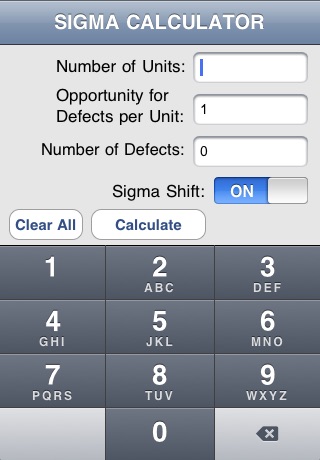
Sigmalator: The Six Sigma Value Calculator app for iPhone and iPad
Developer: Taydan Enterprises LLC
First release : 01 Aug 2009
App size: 32.68 Kb
Six Sigma is a set of strategies, tools, methods, and training programs proven in many industries to greatly improve work processes. This business management strategy began in manufacturing processes to eliminate defects (errors), but since has been broadly applied to a variety of industries including the airline industry and most recently, healthcare. In Six Sigma, a defect is broadly defined as anything that can lead to customer dissatisfaction.
The term “six sigma” is derived from a field of statistics known as process capability studies and comes from the idea that if there are six standard deviations between the average and the nearest defect, there will be practically no errors. Originally, it referred to the ability of manufacturing processes to produce a very high proportion of product within its specifications. Processes that operate with "six sigma quality" over the short term are assumed to produce long-term defect levels below 3.4 defects per million opportunities (DPMO). Six Sigmas implicit goal is to improve all processes to that level of quality or better.
The question is often asked, “What Sigma Level Are We?”. Sigmalator is designed to take the number of defects/errors in a process and calculate a sigma value.
Sigma Levels:
Sigma levels represent the following long-term DPMO values:
• 1 sigma = 690,000 DPMO = 31% efficiency
• 2 sigma = 308,000 DPMO = 69.2% efficiency
• 3 sigma = 66,800 DPMO = 93.32% efficiency
• 4 sigma = 6,210 DPMO = 99.379% efficiency
• 5 sigma = 230 DPMO = 99.9767% efficiency
• 6 sigma = 3.4 DPMO = 99.99966% efficiency
To account for the real-life increase in process variation over time, an empirically-based 1.5 sigma shift is introduced into the calculation. This is based on the fact that a process that is normally distributed will have 3.4 parts per million beyond a point that is 4.5 standard deviations above or below the average. So the 3.4 DPMO of a "Six Sigma" process in fact corresponds to 4.5 sigmas, namely 6 sigmas minus the 1.5 sigma shift introduced to account for long-term variation.
Note: Reporting of “sigma level” is always done having sigma shift turned on by default.



